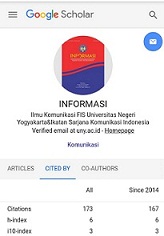Disaster communication of the Merapi slope community
DOI:
https://doi.org/10.21831/informasi.v51i2.45064Keywords:
Merapi, Disaster Communication, Communication ProcessAbstract
References
Dekens, J. (2007). Local knowledge for disaster preparedness: A literature review. International Centre for Integrated Mountain Development (ICIMOD).
Effendy, O U. (2007). Ilmu komunikasi teori dan praktek. PT Remaja Rosdakarya.
Fahriyani, S., Harmaningsih, D., & Yunarti, S. (2020). Penggunaan media sosial Twitter untuk mitigasi bencana di Indonesia. IKRA-ITH HUMANIORA: Jurnal Sosial dan Humaniora, 4(2), 56-65.
Gunawan, G. (2015). Kearifan masyarakat lereng Merapi bagian selatan, Kabupaten Sleman–Daerah Istimewa Yogyakarta. Sosio Informa, 1(2). 189-212
Haddow, K. S., & Haddow, G. D. (2014). Disaster communications in a changing media world (2nd ed.). Elsevier.
Hananto, P. (2014). Opinion leader versus new opinion leader dalam komunikasi pemasaran (studi kasus selebtwit di twitter untuk komunikasi pemasaran). Interaksi: Jurnal Ilmu Komunikasi, 3(2), 140-153.
Hidayati, U. (2019). The political communication process among Chinese moslem society. Informasi, 42(2), 125-143. http://doi.org/10.21831/informasi.v49i2.27989
Jeniarto, J. (2013). Diskursus local wisdom: Sebuah peninjauan persoalan-persoalan. Ultima Humaniora, 1 (2), 1-14.
Kusumasari, B. & Alam, Q. (2012). Local wisdom based disaster recovery model in Indonesia. Disaster Prevention and Management, 21(3). 351- 369.
Martin, E., Nolte, I., & Vitolo, E. (2016). The four Cs of disaster partnering: Communication, cooperation, coordination and collaboration. Disasters, 40(4), 621-643.
Ruslan, R. (2010). Manajemen public relations & media komunikasi. PT Raja Grafindo Persada
Siswadi, A. (2012). 28 kota Indonesia terancaman gunung api. Retrieved 02 13, 2015, from Tempo.Co: http://www.tempo.co/read/news/2012/09/28/061432419/28-Kota-Indonesia-Terancam-LetusanGunung-Api.
Soetomo, S. (2012). Kewaspadaan masyarakat, manifestasi kapasitas masyarakat untuk berkembang secara mandiri. Pustaka Pelajar.
Suherman, A. (2018). Strategi komunikasi bencana pada masyarakat Kabupaten Buton Selatan. Medialog: Jurnal Ilmu Komunikasi, 1(2), 10-18.
Suyuti, H. (2014). Yogyakarta city disaster risk resilience living in harmony. In Presented for "˜Increasing the Resilience of Cities in the Middle East and North Africa', MENA Urbanization Knowledge Platform Conference. Marseille, France–May (pp. 22-23).
Downloads
Published
How to Cite
Issue
Section
Citation Check
License
Authors who publish with this journal agree to the following terms:- Authors retain copyright and grant the journal right of first publication with the work simultaneously licensed under a Creative Commons Attribution License that allows others to share the work with an acknowledgement of the work's authorship and initial publication in this journal.
- Authors are able to enter into separate, additional contractual arrangements for the non-exclusive distribution of the journal's published version of the work (e.g., post it to an institutional repository or publish it in a book), with an acknowledgement of its initial publication in this journal.
- Authors are permitted and encouraged to post their work online (e.g., in institutional repositories or on their website) prior to and during the submission process, as it can lead to productive exchanges, as well as earlier and greater citation of published work (See The Effect of Open Access).
























